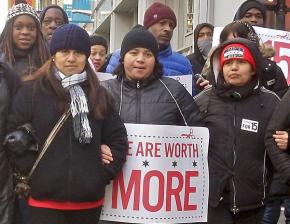A winter of discontent
The Fight for 15 struggle, the groundswell of ecological activism, the election of a Seattle socialist--all are signs of bitterness with the status quo and a desire to change it.
IN THE richest country in the world, millions and millions of people are just barely getting by--and they want to know why.
The system of capitalism--driven by the dogmas of neoliberalism that have made the already gaping divide between the haves and have-nots in U.S. society into a Grand Canyon--is posing unavoidable questions for more and more people, whether they grew up in poverty, or close to it, or they thought they were doing okay until recently.
The class war waged by the rulers of this society--in the economy, in politics and in society at large--has been relentless, and as a result, that questioning doesn't find answers in many cases. Discontent remains just that, with no political expression.
But some people are struggling for answers--and finding them. Sometimes, their efforts have gained national attention, like the wave of walkouts and protests by low-wage workers, or the successful campaign of a socialist running for City Council in Seattle. More often, the struggles are little known beyond those who participate, like local protests for ecological justice, or actions against the latest violence carried out by racist police. But they are no less important for being lesser known.

Small or large, short-lived or ongoing, win or lose, we need to recognize all of these signs of resistance, understand what they teach us about the struggle today, and engage with them, so we can better answer the most important question of all: How can we build up a resistance that can challenge the injustice and inequality we see all around us--and a political alternative that points in a different direction?
EVEN THE official statistics tell a grim story for everyone but the wealthy few in the U.S. today.
As the Washington Post reported in a feature article last month, average household income for the poorest 40 percent of workers in the U.S., once inflation is taken into account, has dropped steadily over the last decade, by more than 10 percent overall since 2000.
Think about your current paycheck, and what it would mean to lose one dollar out of every 10. That's what happened to almost half the working population over the last decade.
Official unemployment is declining steadily, but the fear of losing your job still runs deep. As of October, more than 4 million people were jobless and looking for work for more than half a year. That long-term unemployment rate was down sharply since the high point in early 2010--but it's "still 1 million more than at any point in U.S. history before the Great Recession," the Post reported.
If you're between the ages of 18 and 29, official unemployment is more than 60 percent higher than overall. Graduating from college doesn't guarantee a decent standard of living--some 70 percent of college students in the U.S. will graduate with debts from student loans, with the average debt load at more than $35,000.
That's for the have-nots or have-just-a-littles. If you're lucky enough to count yourself a genuine have, your kind hasn't had it so good in a long, long time. According to federal statistics, the richest 1 percent of Americans grabbed 19.3 percent of household income in 2012. That figure never rose above 10 percent during the entire era after the Second World War until the mid-1980s.
The statistics are daunting enough on their own. But they seem all the more so with the rapid shredding of the already frayed social safety net of government programs that poor and working people rely on. One victim of the latest bipartisan budget agreement: Extended unemployment benefits, still desperately needed by millions to keep food on the table.
Democrats like Barack Obama specialize in appealing for the support of "ordinary Americans" against the budget-cutting and union-busting maniacs of the Republican Party. Thus, Obama last month promised to support a Democratic proposal in Congress to raise the federal minimum wage to $10.10 an hour over several years.
Sounds good--only Obama, the bill's sponsors and everyone else in Washington knows the proposal is a dead letter unless the Democrats take on the Tea Partying Republican leaders of the U.S. House. Until then, Democrats can say anything they want and not deliver--and blame the Republicans for it.
This is an old story, repeated again and again. In New York City, Bill de Blasio emerged from a crowded pack of Democrats running to be mayor by criticizing the "tale of two cities" that grew up under 12 miserable years of Michael Bloomberg, plus the racist injustices perpetrated by the NYPD through the "stop-and-frisk" racial profiling program. Liberal commentators like Peter Beinart claimed de Blasio represented "the rise of a new new left."
But before de Blasio even takes office on January 1, he's proving to be a same-old-same-old Democrat--by, for example, tapping law-and-order fanatic William Bratton to be his police chief.
THAT'S WHY it was such a breath of fresh air when Socialist Alternative candidate Kshama Sawant, a 41-year-old immigrant and community college professor, shocked the Seattle political establishment in November by beating an incumbent Democrat to take a seat on the City Council.
Sawant's campaign highlighted her involvement in the Occupy movement and the Fight for 15 struggle for a living wage, plus her support for rent control and taxes on the rich in order to fund public transportation. Far from downplaying her socialist beliefs, Sawant insisted that they be compared openly to her Democratic opponent.
Sawant's victory in a closely watched, citywide race was a clear example of the frustration, especially among students, young workers and low-income workers, at years of broken promises by Democratic politicians.
But there are other signs of the discontent in Seattle. Within weeks of the election, Sawant was on hand to congratulate a rally of Boeing workers--members of the International Association of Machinists at the nearby Everett, Wash., factory--who had just voted down the company's attempt to blackmail them into accepting an eight-year contract extension containing big concessions.
Washington's Democratic governor and lawmakers fell over themselves to entice Boeing to keep production of the new Boeing 777X aircraft in Everett, but IAM members--declaring that they were taking a stand for all workers--drew the line. And if Boeing does move production out of Washington state, Sawant offered a suggestion at the rally: "[D]emocratic, public ownership by workers and by the community of the workplaces of the big corporations." That's easier said than done, of course, but it certainly showed that socialists have a different alternative to offer.
Meanwhile, just the south of Seattle, residents in the suburb of SeaTac--site of the region's international airport, which thrives on the labor of low-wage service workers--passed a referendum to raise the minimum wage to $15 an hour. Organized labor funded the initiative and sent in organizers to help tip the balance against heavy corporate spending.
With a population of only 27,000, SeaTac is a small place, but the living wage ballot measure is definitely a sign of things to come. In the new year, Sawant and other activists will launch a campaign for a $15-an-hour minimum wage referendum in Seattle, and there are similar initiatives brewing in cities around the country.
THE FIGHT for 15 is thriving beyond just ballot measures--among fast-food and retail workers in a growing number of cities.
The Black Friday walkouts and protests at Walmart in 2012 grabbed national attention as the first activism among store employees at the country's largest private employer and notorious opponent of unions. This year, more people joined in the Ride for Respect caravan to Walmart headquarters in Arkansas and the Black Friday demonstrations last month.
The struggle at the fast-food chains spread throughout this year, with a small but tenacious layer of workers making their voices heard. A different face of the fight seems to have emerged in every city--from the San Diego protests to win back the job of fired McDonald's worker Leobardo Meza; to a raucous occupation of an Oakland, Calif., Jack in the Box led by fired worker Jason Hughes; to the "Strikesgiving" walkout of Whole Foods workers at a Chicago store on Thanksgiving eve to win the holiday off to spend with family; and that's to name but three.
What's more, organized workers have a few success stories to point to this fall, particularly in regions of the country and industries where the economic recovery, shallow though it is, has given union members more confidence to take a stand.
In the San Francisco Bay Area, for example, public transit workers for the BART system spent the summer and fall in a bitter battle with management, including two four-day walkouts--but they came away with a contract that held the line against concessions and made some important gains.
At the same time, Oakland city employees and workers at the Port of Oakland and Oakland International Airport took to the picket lines, as did AFSCME Local 3299 members in the University of California system. And non-union concession workers at the Oakland airport went on strike as well, with the support of UNITE HERE Local 2850.
These few victories and shows of strength don't erase the tremendous damage inflicted on organized labor--in both the public and private sector--during the Great Recession, nor turn the tide in other parts of the country. But we are seeing another side in the class war.
THE EMERGENCE of a new spirit of resistance applies beyond workers' struggles--and the environmental movement is a prime case in point. Despite the depressing evidence that climate change is already taking a toll--not to mention the overwhelming economic and political power of the energy corporations--activists are responding with determination at the grassroots.
Opponents of natural gas fracking have made real advances; the mass mobilizations and many local actions against the Keystone tar sands pipeline have delayed a project the Obama administration clearly wanted to push through; and more than 6,000 people came together for the PowerShift conference of grassroots activists in Pittsburgh.
For next year, the Green Party and ecosocialist network System Change Not Climate Change, among others, are planning for new actions, including an effort to reclaim Earth Day from the corporate greenwashers and link it to May Day struggles by making the connections between workers' rights and sustainability.
There are many other faces of the resistance today. In public education, students, parents and teachers are continuing to confront high-stakes testing, continuing austerity and the rest of the corporate education reform agenda. In Portland, Ore., teachers are gearing up for a possible strike in the new year; in Seattle, there was a successful boycott of the MAP test in several schools; and in New York state, an angry rebellion has erupted against the new Common Core education standards mandated by the Obama administration.
All of the struggles taking place today have been influenced by the successful Chicago Teachers Union strike in September 2012--the "Chicago model" of connecting teacher unionism with the goals of education justice is the talk of activists everywhere. So are the difficult challenges ahead made clear when Democratic Mayor Rahm Emanuel took revenge for the successful CTU strike by closing 50 schools and laying off some 3,000 teachers and staff.
Even on issues where we've lost ground, there have been important developments that can contribute to future struggles.
This summer's acquittal of George Zimmerman, the murderer of Trayvon Martin, proved--if any proof was needed--that racism is alive and well in a country presided over by its first African American president. The verdict also sparked bitter protests and ongoing mobilizations--culminating in a huge turnout for the 50th anniversary of the civil rights movement's 1963 March on Washington--that brought together opponents of racism and activists from many struggles.
The Obama administration sets new records for deportations with every passing day, an ugly betrayal of the hopes of millions of people who voted for Obama--yet young undocumented immigrants are bravely challenging the deportation machine. Thousands of California prisoners launched a heroic hunger strike in defiance of the incarceration nation.
If these struggles remain frustratingly marginalized from mainstream consciousness, we shouldn't ignore the courage of those who are speaking truth to power today, nor the opportunities to organize a stronger movement that can fight and win in the future.
The relentless and ruthless assault on working people and their living standards can grind down the most optimistic person. We haven't seen the end of that assault, either--ultimately, it will continue until we are organized enough and strong enough to stop it.
At the same time, the brewing discontent with what people endure today--in an era of space-age technology, amid ever-greater extremes of wealth--is forcing more and more people to question the dogmas and prejudices that justify the status quo. Socialists need to find every opportunity to give our answers to these questions, in a way that builds the capacity of our side to resist.
That means looking for all the chances for activism--whatever the issue--in every city and town, on every campus, in every community. And it means looking for all the ways we can build up socialist organization. With no overarching struggle or movement like Occupy at the moment, socialists can provide the forum for those committed to social justice to debate and discuss the political questions we face, learn the history and theory we need to confront the struggles of today, and make the links between all the different fights and movements that do emerge.
The case against capitalism and the crimes caused by it has never been more obvious. And the need to build a socialist organization active in all the struggles of today, while looking forward to the fight for a new world, has never been more urgent.


